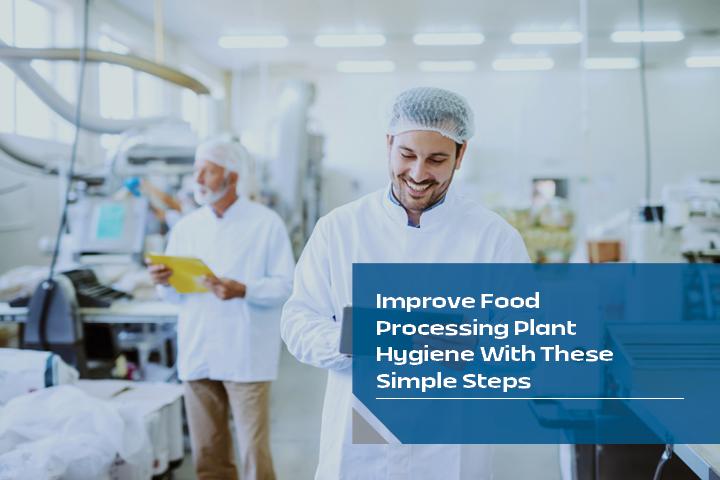Today, there is an increasing demand for healthy high-quality foods, and facilities are working to meet that demand. But no matter what foods a facility produces, contamination is a significant concern. This means that hygiene needs to be a top priority. For these facilities, hygiene goes beyond hand washing and mopping the floors — it includes having the proper layout and zoning, using the right equipment, having cleaning schedules, and so much more
Proper food processing plant hygiene is not only vital to the success of the facility but is required by law. Facilities that fail to adhere to the hygiene requirements set forth by the government can face serious penalties, fines, and legal problems.
Proper Zoning And Layout
Zoning is the separation of areas in a facility, with each having different hygiene requirements. There are three zones to consider: Zone B, where hygiene concerns are minimal; Zone M, which has medium-level hygiene concerns; and Zone H, where hygiene concerns are greatest. Applying zones effectively and consistently is one step in ensuring proper food processing plant hygiene.
The layout of the facility is also critical. It should make sense and be adapted to the zoning and hygiene requirements of a given process. Materials, personnel, air, and waste should all flow in the correct direction. Raw materials and ingredients should go from one end of the facility, the "dirty" area, to the other, the "clean" area, where the processed food is prepared for packaging and shipping. In contrast, waste materials should flow in the opposite direction to avoid the contamination and degradation of finished products.
Pest Prevention
Pests such as rodents, insects, and birds can create hygiene issues for a facility. As preventative measures, facilities should be built higher than the surrounding ground, and exterior doors should not open into the production area, where there should be no windows.
There should be as few loading docks as possible, above ground and with sloped floors to allow for water runoff. Roofs and canopies with bird spikes can be added to docks to protect products while preventing birds from roosting as that can lead to serious sanitation problems. Further protection from insects can be provided by air curtains or plastic strips and strategically placed lighting and UV grids.
Proper Drainage and Construction Materials
All the construction materials in a facility must meet specific requirements. They should be hygienic and made with smooth, non-absorbent, and non-toxic materials. They also require chemical resistance, and physical durability — being unbreakable; heat, cold, and moisture resistant; and resistant to abrasions and chipping.
While non-food contact areas can include lower grade materials, food production areas require high-quality finishes. All materials should be easy to clean and maintain. Important materials range from the lighting to the drainage.
A floor drain system requires sufficient water capacity to prevent overflow, which leads to contamination. Slot Drain's linear trench drain system is a unique option that comes pre-sloped and pre-assembled and doesn't require a grate cover. These high-capacity systems are made from food-grade stainless steel, making them resistant to chemicals, corrosion, extreme temperatures, odor, and bacteria.
Furthermore, Slot Drain’s industrial 9,000 and 10,000 Series models have a high weight-bearing capacity, making them ideal for food processing plants. These systems are also easy to clean and offer automated options such as Flush Flo and Clean-In-Place.
Cleaning Schedules
Even with the proper zoning, layout, pest control measures, and construction materials, if a facility isn't cleaned regularly, the hygiene level will suffer. Therefore, a regular cleaning schedule and procedures need to be developed and provided to employees. Every part of the facility needs to be cleaned accordingly to ensure adequate cleanliness. Beyond that, employees should receive training on cleaning procedures to ensure they know how to keep the facility clean and free from contamination.
Even with automated cleaning systems, like Clean-In-Place, inspections to ensure all dirt and debris is removed are critical. When these systems are in place for any part of the facility, ensure that employees know to check the area and do extra cleaning physically as necessary.
Protect Your Facility
Food processing plant hygiene is essential to running a contamination-free facility. While handwashing and proper employee attire are important, the precautions outlined in this article are even more critical. Without the right zoning, layout, materials, pest control measures, and cleaning schedules, a facility will face hygiene and contamination issues.
Even the smallest mistake can lead to serious consequences, affecting a facility's earnings and reputation. Therefore, it is vital to plan a facility thoroughly to ensure the proper food processing plant hygiene from top to bottom.
Improve your food processing hygiene with a Slot Drain system. Contact us today to get a quote for your project.


